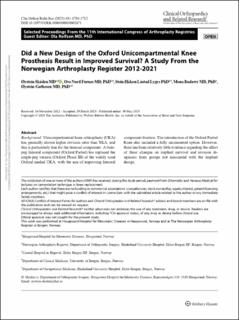Did a New Design of the Oxford Unicompartmental Knee Prosthesis Result in Improved Survival? A Study From the Norwegian Arthroplasty Register 2012-2021
Skåden, Øystein; Furnes, Ove Nord; Lygre, Stein Håkon Låstad; Badawy, Mona; Gøthesen, Øystein Johannes
Journal article, Peer reviewed
Published version

Åpne
Permanent lenke
https://hdl.handle.net/11250/3117229Utgivelsesdato
2023Metadata
Vis full innførselSamlinger
- Department of Clinical Medicine [2044]
- Registrations from Cristin [9514]
Originalversjon
Clinical Orthopaedics and Related Research. 2023, 481 (9), 1703-1712. 10.1097/CORR.0000000000002671Sammendrag
Background
Unicompartmental knee arthroplasty (UKA) has generally shown higher revision rates than TKA, and this is particularly true for the femoral component. A twin-peg femoral component (Oxford Partial) has replaced the single-peg version (Oxford Phase III) of the widely used Oxford medial UKA, with the aim of improving femoral component fixation. The introduction of the Oxford Partial Knee also included a fully uncemented option. However, there has been relatively little evidence regarding the effect of these changes on implant survival and revision diagnoses from groups not associated with the implant design.
Questions/purposes
Using data from the Norwegian Arthroplasty Register, we asked: (1) Has the 5-year implant survival (free from revision for any cause) improved with the medial Oxford unicompartmental knee after the introduction of new designs? (2) Did the causes of revision change between the old and new designs? (3) Is there a difference in risk for specific revision causes between the uncemented and cemented versions of the new design?
Methods
We performed a registry-based observational study using data from the Norwegian Arthroplasty Register, a nationwide, mandatory and governmental registry with a high reporting rate. Between 2012 and 2021, 7549 Oxford UKAs were performed, and 105 were excluded due to combinations of the three designs, lateral compartment replacement, or hybrid fixation, leaving 908 cemented Oxford Phase III single-peg (used from 2012 to 2017), 4715 cemented Oxford Partial twin-peg (used from 2012 to 2021), and 1821 uncemented Oxford Partial twin-peg (used from 2014 to 2021), UKAs available for the analysis. The Kaplan-Meier method and Cox regression multivariate analysis were used to find the 5-year implant survival and the risk of revision (hazard ratio), when adjusting for age, gender, diagnosis, American Society of Anesthesiologists grade, and time period. The risk of revision for any cause and the risk of revision for specific causes were compared, first for the older with the two new designs, and second for the cemented with the uncemented version of the new design. Revision was defined as any operation exchanging or removing implant parts.
Results
The 5-year Kaplan-Meier overall implant survival (free from revision for any cause) for the medial Oxford Partial unicompartmental knee did not improve over the study period. The 5-year Kaplan-Meier survival was different (p = 0.03) between the groups: it was 92% (95% confidence interval [CI] 90% to 94%) for the cemented Oxford III, 94% (95% CI 93% to 95%) for the cemented Oxford Partial, and 94% (95% CI 92% to 95%) for the uncemented Oxford Partial. However, the overall risk of revision during the first 5 years was not different between the groups (Cox regression HR 0.8 [95% CI 0.6 to 1.0]; p = 0.09 and 1.0 [95% CI 0.7 to 1.4]; p = 0.89 for the cemented Oxford Partial and the uncemented Oxford Partial, respectively, compared with cemented Oxford III [HR 1]). The uncemented Oxford Partial had a higher risk of revision for infection (HR 3.6 [95% CI 1.2 to 10.5]; p = 0.02) compared with the cemented Oxford III. The uncemented Oxford Partial had a lower risk of revision for pain (HR 0.5 [95% CI 0.2 to 1.0]; p = 0.045) and instability (HR 0.3 [95% CI 0.1 to 0.9]; p = 0.03) compared with the cemented Oxford III. The cemented Oxford Partial had a lower risk of revision for aseptic femoral loosening (HR 0.3 [95% CI 0.1 to 1.0]; p = 0.04) compared with the cemented Oxford III. When comparing the uncemented and cemented versions of the new design, the uncemented Oxford Partial had a higher risk of revision for periprosthetic fracture (HR 15 [95% CI 4 to 54]; p = 0.001) and infection within the first year (HR 3.0 [95% CI 1.5 to 5.7]; p = 0.001) than the cemented Oxford Partial.
Conclusion
Considering that we found no difference in overall risk of revision during the first 5 years but we found a higher risk of revision for infection, periprosthetic fracture, and higher per implant cost, we currently would recommend against the use of uncemented Oxford Partial over the cemented Oxford Partial or the cemented Oxford III.
